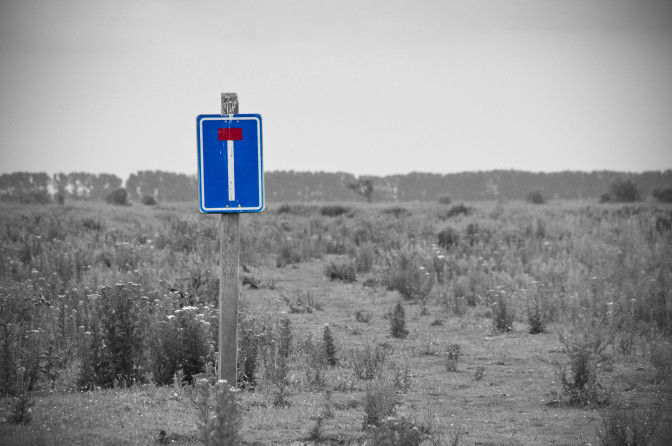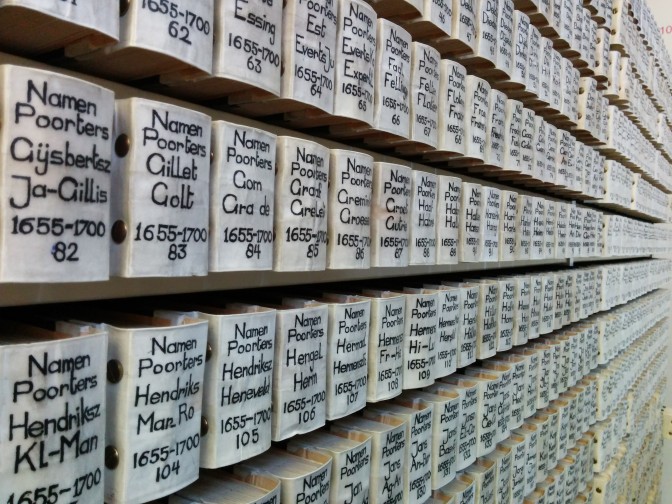I don’t call an ancestor a “brick wall” until I feel that I’ve exhausted the research options. Instead, I prefer “dead end” to indicate ancestors for whom I have not identified the parents yet.
I have about two thousand ancestors in my tree for whom I have not identified both parents. To give you an idea of the types of problems you can run into when researching Dutch ancestors, I will discuss the different types of “dead ends” in my tree.

Dead end nature. Credits: Bert Kauffman, Flickr (CC-BY-SA).
Fathers of illegitimate children
My most recent “dead ends” are the fathers of four ancestors who were born out of wedlock in the 1800s. In one case, I have a theory about the father, but in the other cases I don’t. I have exhausted the research options for now, until an unknown cousin happens to take a DNA test and traces back to one of the mother’s associates.
Immigrants
Even though I’m quite Dutch, I have a handful of immigrant ancestors, including Swiss and Scottish mercenary soldiers. I have not been able to trace them yet, because the resources are not online and I have not done any research locally. These lines are in the 1600s, when many foreign troops came to the Netherlands in the Eighty Years War.
Records online but not indexed
For a few dozen ancestors on my mother’s side, the church records for the places where she lived have not been indexed yet. The scans have become available online in recent years, but I have not taken the time yet to browse them manually. I would never consider these “brick walls,” just “dead ends” for now. Most of these are in the late 1600s.
Records indexed but not online
In about a hundred cases, I have found references to records that may help me to identify the parents, but I have not consulted the original records yet. These references may have been found in indexes or in literature searches.
In several of these cases, I know these records will be digitized and made available in the next few years, so I will wait for that. There are only so many hours in the day!
Records not online and not indexed
Similarly, I have a couple of hundred dead ends for which I have exhausted the online available resources, but for which there exist a range of records that can be consulted on-site in the archives. Most of these dead ends are in the 1500s or early 1600s. I do this occasionally, but most will probably have to wait until I retire, in forty years or so 🙂

Index of poorterboeken, Amsterdam City Archives. Photo by author.
No known records
And now we get to what I consider solid brick walls. These ancestors that lived so long ago, that their lives apparently went unrecorded. Many of my ancestors were poor and did not own any property. Some of them were serfs. Before say 1500 or 1600, depending on the area, most of their lives were unrecorded. These brick walls are too far back for DNA to be of any use, since there are no documented lines to compare to.
For many towns in the Netherlands, court records (usually starting in the 1500s or 1600s) or church records of baptisms, marriage, and burials (usually starting in the 1600s) are the earliest records to capture a large part of the population. Before that, poor people are all but impossible to trace. Over a thousand of my “dead ends” fall in this category. Since I have about two thousand dead ends in total, I guess that means I’m halfway there 🙂
Your types of dead ends?
If you look at your own tree, what are some reasons you have not been able to identify parents? I would love to hear from you and address these problems in future posts, so please leave a comment.


Because a lot of your examples are circumstances involving a lack of time, access, or opportunity to fully explore the available records, I’d be even more generous say it’s more like having pit-stops along the way rather than coming up to any real dead ends. 🙂
Van ‘s-Gravendeel zijn de doop en trouw boeken als ‘ouwe troep’ verbrand = weg, ca. 100 jaar geleden. Onder ‘s-Gravendeel viel ook Wieldrecht kerkelijk. . En van de Sint Anthoniepolder zijn de 18e eeuwde doop en trouw boeken verdwenen. In beide plaatsen heb ik veel ouders. Vanaf ca. 1800 woonde mijn familie Bos in Cillaarshoek, grenzend aan beide genoemde plaatsen.
Inability to read Dutch and the overwhelming thought of trying to understand yet another country’s records system. I take the path of least resistance: I speak English so I research my ancestors from England. I know there is that one Dutch line out there, lurking…….I follow your blog, so I know there is hope!
Your clear explanations give hope that the “dead ends” in my family tree can also be uncovered. My last name doesn’t sound Dutch but two of my husbands grand parents were born in the Netherlands, and 6 of 8 of my great grandparents were of Dutch blood, born here in Holland, Michigan.
Most Dutch people in Michigan can easily be traced back to the Netherlands by studying their US reboots including neighbors and associates. I have not seen any Holland, Michigan dead ends that I would qualify as a brick wall 🙂
I am so glad that the Dutch government took the initiative to require all provinces to digitize genealogy records and make them available on the internet. From my desk in the United States I am able to search the archives in Gelderland, Noord-Brabant, Utrecht, etc. for my decendants. At this point, I have 2055 people in my family tree and have copies of the documents to back up the data. Several family lines now go back into the mid-1600’s, or the early 1700’s. Yvette, thank you for the information you share on this website, your site has given me information about other sources where I can find information.
I am a novice to genealogy but have been able to accurately trace my family (I live in California) to Simon Hendricks van Scheltinga 1485–1538 (Birth: Kimswerd, Wunseradiel, Friesland, Netherlands | Death 26 APR 1538 • Harlingen, Friesland, Netherlands). But now have hit a dead end. I guess I am not even sure what sort of dead end I hit…or where to go next. Is this the true end of the road?
Any suggestions are appreciated
Research in Friesland before 1600 is complex. A typical research plan would start by doing a literature search, and find out what sources are available for Kimswerd in that period. Few records for the 1500s survive, and those that do are mostly not online, and are not indexed. I do not know if you speak Dutch and can do on-site research, but otherwise it could be that you have hit the end of the line for now. It also depends on the social status: if the family belonged to the upper classes, there may be more records than if they belonged to the majority who were farmers or laborers.